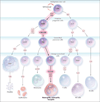Colony-stimulating factors for febrile neutropenia during cancer therapy
- PMID: 23514290
- PMCID: PMC3947590
- DOI: 10.1056/NEJMct1210890
Colony-stimulating factors for febrile neutropenia during cancer therapy
Erratum in
- N Engl J Med. 2013 Jul 18;369(3):293. Dosage error in article text
Abstract
A 55-year-old, previously healthy woman received a diagnosis of diffuse large-B-cell lymphoma after the evaluation of an enlarged left axillary lymph node obtained on biopsy. She had been asymptomatic except for the presence of enlarged axillary lymph nodes, which she had found while bathing. She was referred to an oncologist, who performed a staging evaluation. A complete blood count and test results for liver and renal function and serum lactate dehydrogenase were normal. Positron-emission tomography and computed tomography (PET–CT) identified enlarged lymph nodes with abnormal uptake in the left axilla, mediastinum, and retroperitoneum. Results on bone marrow biopsy were normal. The patient’s oncologist recommends treatment with six cycles of cyclophosphamide, doxorubicin, vincristine, and prednisone with rituximab (CHOP-R) at 21-day intervals. Is the administration of prophylactic granulocyte colony-stimulating factor (G-CSF) with the first cycle of chemotherapy indicated?
Figures

Comment in
-
Colony-stimulating factors for febrile neutropenia.N Engl J Med. 2013 Jul 18;369(3):286. doi: 10.1056/NEJMc1306109. N Engl J Med. 2013. PMID: 23863062 No abstract available.
-
Colony-stimulating factors for febrile neutropenia.N Engl J Med. 2013 Jul 18;369(3):284. doi: 10.1056/NEJMc1306109. N Engl J Med. 2013. PMID: 23863063 No abstract available.
-
Colony-stimulating factors for febrile neutropenia.N Engl J Med. 2013 Jul 18;369(3):284-5. doi: 10.1056/NEJMc1306109. N Engl J Med. 2013. PMID: 23863064 No abstract available.
-
Colony-stimulating factors for febrile neutropenia.N Engl J Med. 2013 Jul 18;369(3):285. doi: 10.1056/NEJMc1306109. N Engl J Med. 2013. PMID: 23863065 No abstract available.
-
Colony-stimulating factors for febrile neutropenia.N Engl J Med. 2013 Jul 18;369(3):285-6. doi: 10.1056/NEJMc1306109. N Engl J Med. 2013. PMID: 23863066 No abstract available.
References
-
- Smith TJ, Khatcheressian J, Lyman GH, et al. 2006 Update of recommendations for the use of white blood cell growth factors: an evidence-based clinical practice guideline. J Clin Oncol. 2006;24:3187–3205. - PubMed
-
- Aapro MS, Bohlius J, Cameron DA, et al. 2010 Update of EORTC guidelines for the use of granulocyte-colony stimulating factor to reduce the incidence of chemotherapy-induced febrile neutropenia in adult patients with lymphoproliferative disorders and solid tumours. Eur J Cancer. 2011;47:8–32. - PubMed
-
- National Comprehensive Cancer Network. Myeloid growth factors v1020012. ( http://www.nccn.org)
-
- Caggiano V, Weiss RV, Rickert TS, Linde-Zwirble WT. Incidence, cost and mortality of neutropenia hospitalization associated with chemotherapy. Cancer. 2005;103:1916–1924. - PubMed
-
- Bodey GP, Buckley M, Sathe YS, Freireich EJ. Quantitative relationships between circulating leukocytes and infection in patients with acute leukemia. Ann Intern Med. 1966;64:328–340. - PubMed
Publication types
MeSH terms
Substances
Grants and funding
LinkOut - more resources
Full Text Sources
Other Literature Sources
Research Materials
